Carbon Dioxide Gas Sensor Based on Polyhexamethylene Biguanide Polymer Deposited on Silicon Nano-Cylinders Metasurface
Abstract
1. Introduction
2. Device Design and Theory
2.1. Narrowband PA Design
2.2. Silicon Nano-Cylinder Metasurface Coated with PHMB Polymer Layer for CO2 Gas Detection
3. Optimization of Narrowband PA Design
3.1. Variation in R at Constant Remaining Parameters
3.2. Variation in HSi at Constant Remaining Parameters
3.3. Variation in d at Constant Remaining Parameters
3.4. R/T/A Plot and AOI of X-Oriented and Y-Oriented Field
4. CO2 Gas Sensing Based on Wavelength Interrogation Method
5. Anticipated Manufacturing Process
6. Conclusions
Author Contributions
Funding
Institutional Review Board Statement
Informed Consent Statement
Data Availability Statement
Acknowledgments
Conflicts of Interest
References
- Alaee, R.; Albooyeh, M.; Rockstuhl, C. Theory of metasurface based perfect absorbers. J. Phys. D Appl. Phys. 2017, 50, 503002. [Google Scholar] [CrossRef]
- Rhee, J.Y.; Kim, Y.J.; Yi, C.; Hwang, J.S.; Lee, Y.P. Recent progress in perfect absorbers by utilizing metamaterials. J. Electromagn. Waves Appl. 2020, 34, 1338–1371. [Google Scholar] [CrossRef]
- Zhao, L.; Liu, H.; He, Z.; Dong, S. Design of multi-narrowband metamaterial perfect absorbers in near-infrared band based on resonators asymmetric method and modified resonators stacked method. Opt. Commun. 2018, 420, 95–103. [Google Scholar] [CrossRef]
- Rafangura, P.; Sabah, C. Dual-band perfect metamaterial absorber for solar cell applications. Vacuum 2015, 120, 68–74. [Google Scholar] [CrossRef]
- Savo, S.; Shrekenhamer, D.; Padilla, W.J. Liquid crystal metamaterial absorber spatial light modulator for THz applications. Adv. Opt. Mater. 2014, 2, 275–279. [Google Scholar] [CrossRef]
- Rifat, A.A.; Rahmani, M.; Xu, L.; Miroshnichenko, A.E. Hybrid metasurface based tunable near-perfect absorber and plasmonic sensor. Materials 2018, 11, 1091. [Google Scholar] [CrossRef]
- Mavrakakis, K.; Booske, J.H.; Behdad, N. Narrowband, infrared absorbing metasurface using polystyrene thin films. J. Appl. Phys. 2020, 127, 074504. [Google Scholar] [CrossRef]
- Katrodiya, D.; Jani, C.; Sorathiya, V.; Patel, S.K. Metasurface based broadband solar absorber. Opt. Mater. 2019, 89, 34–41. [Google Scholar] [CrossRef]
- Aoni, R.A.; Rahmani, M.; Xu, L.; Kamali, K.Z.; Komar, A.; Yan, J.; Neshev, D.; Miroshnichenko, A.E. High-efficiency visible light manipulation using dielectric metasurfaces. Sci. Rep. 2019, 9, 6510. [Google Scholar] [CrossRef]
- Wang, J. Metasurfaces enabling structured light manipulation: Advances and perspectives. Chin. Opt. Lett. 2018, 16, 050006. [Google Scholar] [CrossRef]
- Bhattarai, K.; Silva, S.; Song, K.; Urbas, A.; Lee, S.J.; Ku, Z.; Zhou, J. Metamaterial perfect absorber analyzed by a metacavity model consisting of multilayer metasurfaces. Sci. Rep. 2017, 7, 10569. [Google Scholar] [CrossRef] [PubMed]
- He, J.; Ding, P.; Wang, J.; Fan, C.; Liang, E. Ultra-narrow band perfect absorbers based on plasmonic analog of electromagnetically induced absorption. Opt. Express 2015, 23, 6083–6091. [Google Scholar] [CrossRef] [PubMed]
- Dao, T.D.; Ishii, S.; Yokoyama, T.; Sawada, T.; Sugavaneshwar, R.P.; Chen, K.; Wada, Y.; Nabatame, T.; Nagao, T. Hole array perfect absorbers for spectrally selective midwavelength infrared pyroelectric detectors. ACS Photonics 2016, 3, 1271–1278. [Google Scholar] [CrossRef]
- Wang, Y.; Ma, X.; Li, X.; Pu, M.; Luo, X. Perfect electromagnetic and sound absorption via subwavelength holes array. Opto-Electron. Adv. 2018, 1, 180013. [Google Scholar] [CrossRef]
- Xiong, X.; Jiang, S.-C.; Hu, Y.-H.; Peng, R.-W.; Wang, M. Structured metal film as a perfect absorber. Adv. Mater. 2013, 25, 3994–4000. [Google Scholar] [CrossRef] [PubMed]
- Butt, M.A.; Kazanskiy, N.L. Narrowband perfect metasurface absorber based on impedance matching. Photonics Lett. Pol. 2020, 12, 88–90. [Google Scholar]
- Hansen, J.; Sato, M.; Kharecha, P.; Beerling, D.; Berner, R.; Masson-Delmotte, V.; Pagani, M.; Raymo, M.; Royer, D.L.; Zachos, J.C. Target atmospheric CO2: Where should humanity aim? Open Atmos. Sci. J. 2008, 2, 217–231. [Google Scholar] [CrossRef]
- Stewart, G.; Jin, W.; Culshaw, B. Prospects for fibre-optic evanescent-field gas sensors using absorption in the near infrared. Sens. Actuators B Chem. 1997, 38, 42–47. [Google Scholar] [CrossRef]
- Butt, M.A.; Degtyarev, S.A.; Khonina, S.N.; Kazanskiy, N.L. An evanescent field absorption gas sensor at mid-IR 3.39 μm wavelength. J. Mod. Opt. 2017, 64, 1892–1897. [Google Scholar] [CrossRef]
- Kazanskiy, N.L.; Khonina, S.N.; Butt, M.A. Polarization-Insensitive hybrid plasmonic waveguide design for evanescent field absorption gas sensor. Photon. Sens. 2020. [Google Scholar] [CrossRef]
- El Shamy, R.S.; Khalil, D.; Swillam, A. Mid infrared optical gas sensor using plasmonic Mach-Zehnder interferometer. Sci. Rep. 2020, 10, 1293. [Google Scholar] [CrossRef] [PubMed]
- Liedberg, B.; Nylander, C.; Lunstrom, I. Surface plasmon resonance for gas detection and biosensing. Sens. Actuators 1983, 4, 299–304. [Google Scholar] [CrossRef]
- Ranacher, C.; Consani, C.; Tortschanoff, A.; Jannesari, R.; Bergmeister, M.; Grille, T.; Jakoby, B. Mid-infrared absorption gas sensing using a silicon strip waveguide. Sens. Actuators A Phys. 2018, 277, 117–123. [Google Scholar] [CrossRef]
- Ranacher, C.; Consani, C.; Hedenig, U.; Grille, T.; Lavchiev, V.; Jakoby, B. A photonic silicon waveguide gas sensor using evanescent-wave absorption. In Proceedings of the 2016 IEEE Sensors, Orlando, FL, USA, 30 October–3 November 2016; pp. 1–3. [Google Scholar] [CrossRef]
- Swain, S.K.; Phaomei, G.; Swain, S.K.; Sahoo, N.K.; Tripathy, S.K. A new configuration of fiber optic sensor based on evanescent field absorption utilizing the emission properties of Fe3O4 @ BaMoO4: Eu nanocomposite probe. Optics Commun. 2020, 471, 125842. [Google Scholar] [CrossRef]
- Qiao, Y.; Tao, J.; Qiu, J.; Hong, X.; Wu, J. Sensitive and ultrasmall sample volume gas sensor based on a sealed slot waveguide. Appl. Opt. 2019, 58, 4708–4713. [Google Scholar] [CrossRef]
- Green, W.M.J.; Zhang, E.J.; Xiong, C.; Martin, Y.; Orcutt, J.; Glodde, M.; Schares, L.; Barwicz, T.; Teng, C.C.; Marchack, N.; et al. Silicon Photonic Gas Sensing. In Proceedings of the Optical Fiber Communication Conference (OFC), San Diego, CA, USA, 3–7 March 2019. [Google Scholar]
- Badri, S.H. Transmission resonances in silicon subwavelength grating slot waveguide with functional host material for sensing applications. Opt. Laser Technol. 2021, 136, 106776. [Google Scholar] [CrossRef]
- Butt, M.A.; Khonina, S.N.; Kazanskiy, N.L. Ultrashort inverted tapered silicon ridge-to-slot waveguide coupler at 1.55 μm and 3.392 μm wavelength. Appl. Opt. 2020, 59, 7821–7828. [Google Scholar] [CrossRef] [PubMed]
- Zaky, Z.A.; Ahmed, A.M.; Shalaby, A.S.; Aly, A.H. Refractive index gas sensor based on the Tamm state in a one-dimensional photonic crystal: Theoretical optimisation. Sci. Rep. 2020, 10, 9736. [Google Scholar] [CrossRef] [PubMed]
- Pandey, A.K. Plasmonic sensor utilizing Ti3C2TxMXene layer and fluoride glass substrate for bio- and gas-sensing applications: Performance evaluation. Photonics Nanostruct. Fund. Appl. 2020, 42, 100863. [Google Scholar] [CrossRef]
- Antonacci, G.; Goyvaerts, J.; Zhao, H.; Baumgartner, B.; Lendl, B.; Baets, R. Ultra-sensitive refractive index gas sensor with functionalized silicon nitride photonic circuits. APL Photonics 2020, 5, 081301. [Google Scholar] [CrossRef]
- Ariannejad, M.M.; Akbari, E.; Hanafi, E. Silicon sub-wavelength grating resonator structures for gas sensor. Superlatt. Microstruct. 2020, 142, 106506. [Google Scholar] [CrossRef]
- Khonina, S.N.; Kazanskiy, N.L.; Butt, M.A. Evanescent field ratio enhancement of a modified ridge waveguide structure for methane gas sensing application. IEEE Sens. J. 2020, 20, 8469–8476. [Google Scholar] [CrossRef]
- Butt, M.A.; Khonina, S.N.; Kazanskiy, N.L. Modelling of rib channel waveguides based on silicon-on-sapphire at 4.67 μm wavelength for evanescent field gas absorption sensor. Optik 2018, 168, 692–697. [Google Scholar] [CrossRef]
- Butt, M.A.; Kazanskiy, N.L. SOI suspended membrane waveguide at 3.39 μm for gas sensing application. Photonics Lett. Pol. 2020, 12, 67–69. [Google Scholar] [CrossRef]
- Butt, M.A.; Khonina, S.N.; Kazanskiy, N.L. A highly sensitive design of subwavelength grating double-slot waveguide microring resonator. Laser Phys. Lett. 2020, 17, 076201. [Google Scholar] [CrossRef]
- Mi, G.; Horvath, C.; Aktary, M.; Van, V. Silicon microring refractometric sensor for atmospheric CO2 gas monitoring. Opt. Express 2016, 24, 1773–1780. [Google Scholar] [CrossRef]
- Padilla, W.J.; Basov, D.N.; Smith, D.R. Negative refractive index metamaterials. Materialstoday 2006, 9, 28–35. [Google Scholar] [CrossRef]
- Swett, D.W. Near zero index perfect metasurface absorber using inverted conformal mapping. Sci. Rep. 2020, 10, 9731. [Google Scholar] [CrossRef]
- Azuma, K.; Kagi, N.; Yanagi, U.; Osawa, H. Effects of low-level inhalation exposure to carbon dioxide in indoor environments: A short review on human health and psychomotor performance. Environ. Int. 2018, 121, 51–56. [Google Scholar] [CrossRef]
- Anderson, T.R.; Hawkins, E.; Jones, P.D. CO2, the greenhouse effect and global warming: From the pioneering work of Arrhenius and Callendar to today’s Earth system Models. Endeavour 2016, 40, 178–187. [Google Scholar] [CrossRef]
- Ma, W.; Xing, J.; Wang, R.; Rong, Q.; Zhang, W.; Li, Y.; Zhang, J.; Qiao, X. Optical fiber fabry-perot interferometric CO2 gas sensor using guanidine derivative polymer functionalized layer. IEEE Sens. J. 2018, 18, 1924–1929. [Google Scholar] [CrossRef]
- Lang, T.; Hirsch, T.; Fenzl, C.; Brandl, F.; Wolfbeis, O.S. Surface plasmon resonance sensor for dissolved and gaseous carbon dioxide. Anal. Chem. 2012, 84, 9085–9088. [Google Scholar] [CrossRef] [PubMed]
- Li, H.; Sun, B.; Yuan, Y.; Yang, J. Guanidine derivative polymer coated microbubble resonator for high sensitivity detection of CO2 gas concentration. Opt. Express 2019, 27, 1991–2000. [Google Scholar] [CrossRef] [PubMed]
- Badloe, T.; Mun, J.; Rho, J. Metasurfaces-based absorption and reflection control: Perfect absorbers and reflectors. J. Nanomater. 2017, 2017, 1–18. [Google Scholar] [CrossRef]
- Mi, G.; Horvath, C.; Van, V. Silicon photonic dual-gas sensor for H2 and CO2 detection. Opt. Express 2017, 25, 16250–16259. [Google Scholar] [CrossRef]
- Koushik, K.P.; Malathi, S. Optical Micro-ring Resonator for Detection of Carbon Dioxide Gas. In Signal and Information Processing, Networking and Computers; Springer: Singapore, 2020; Volume 649, pp. 157–161. [Google Scholar]
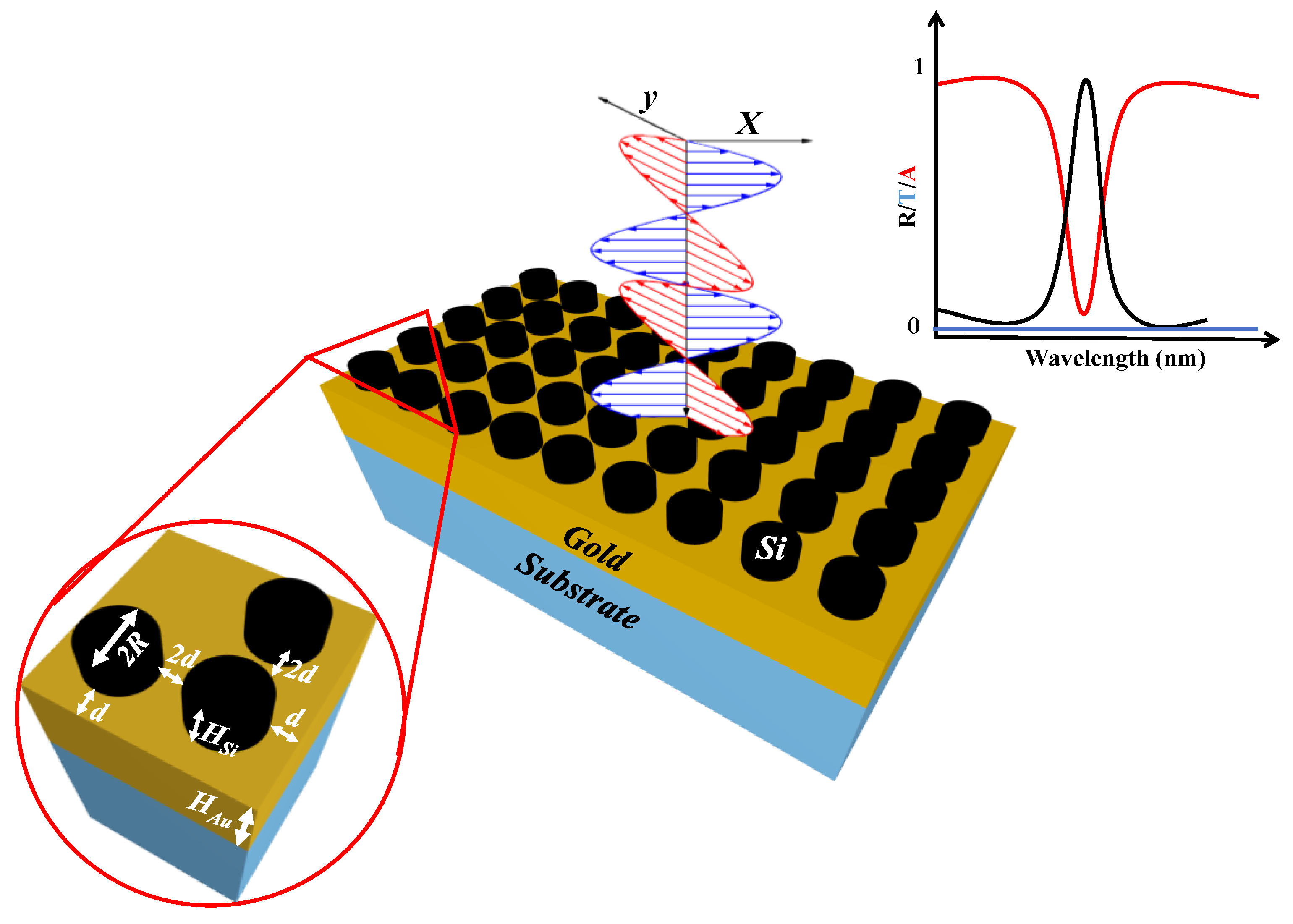
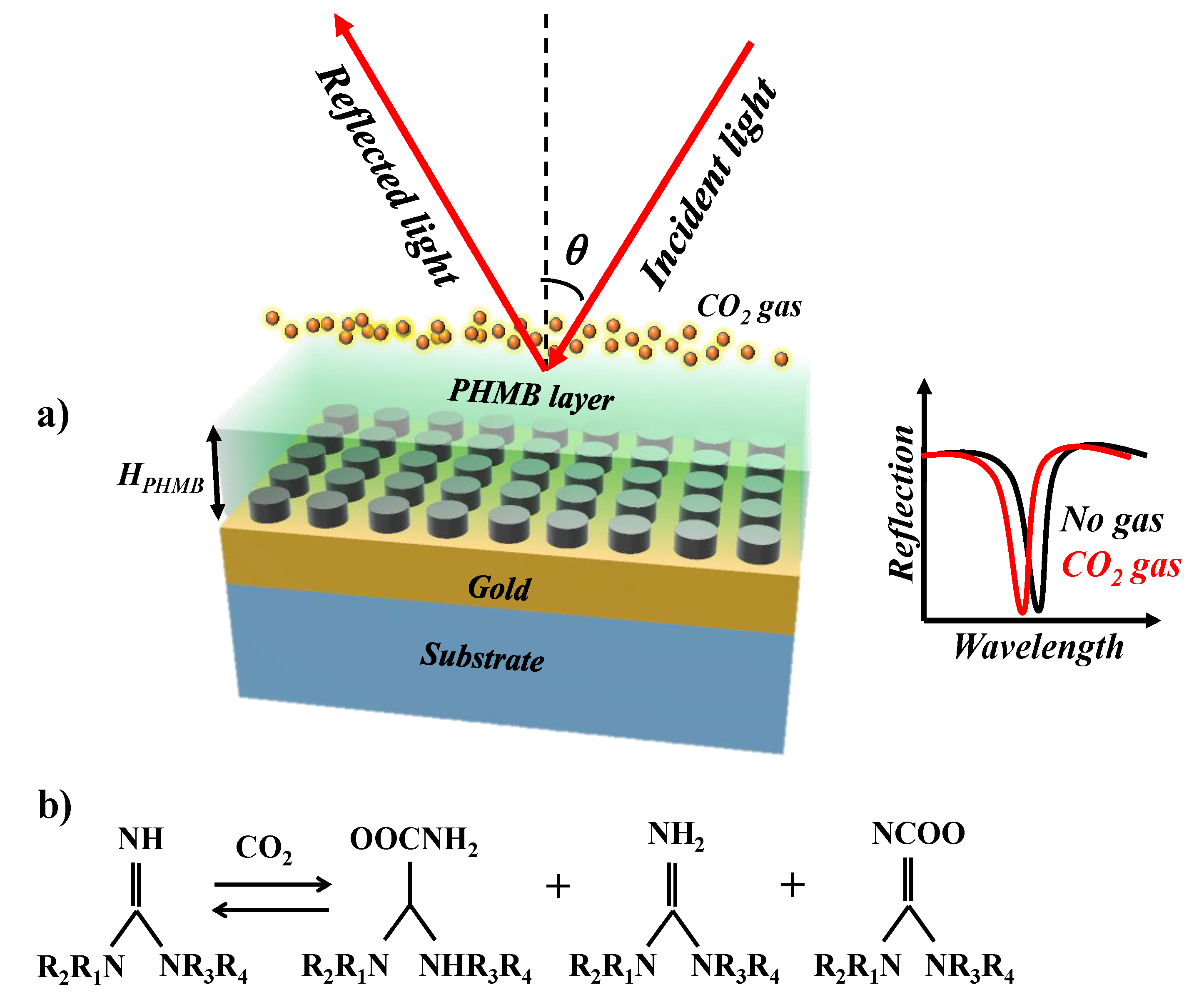
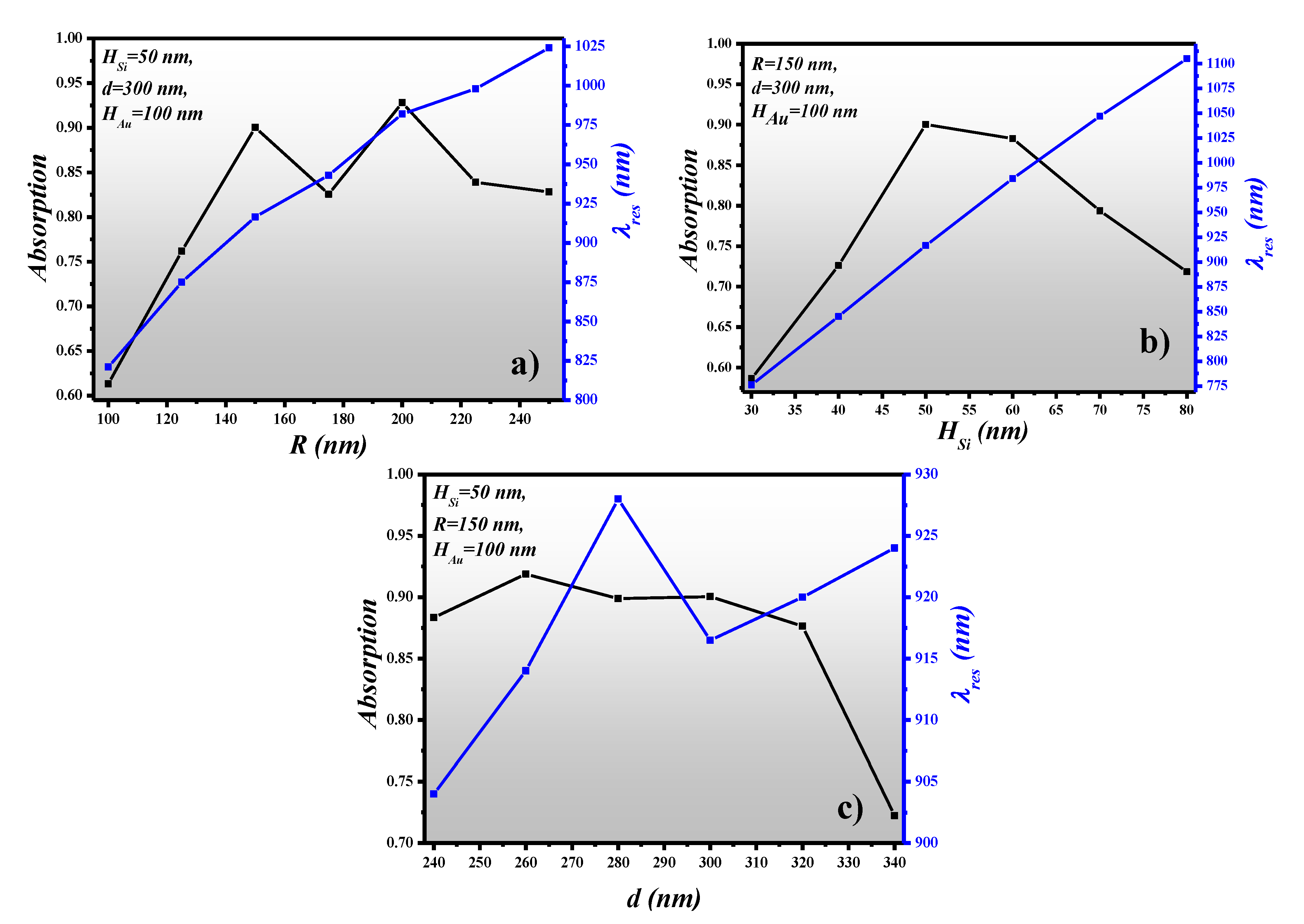
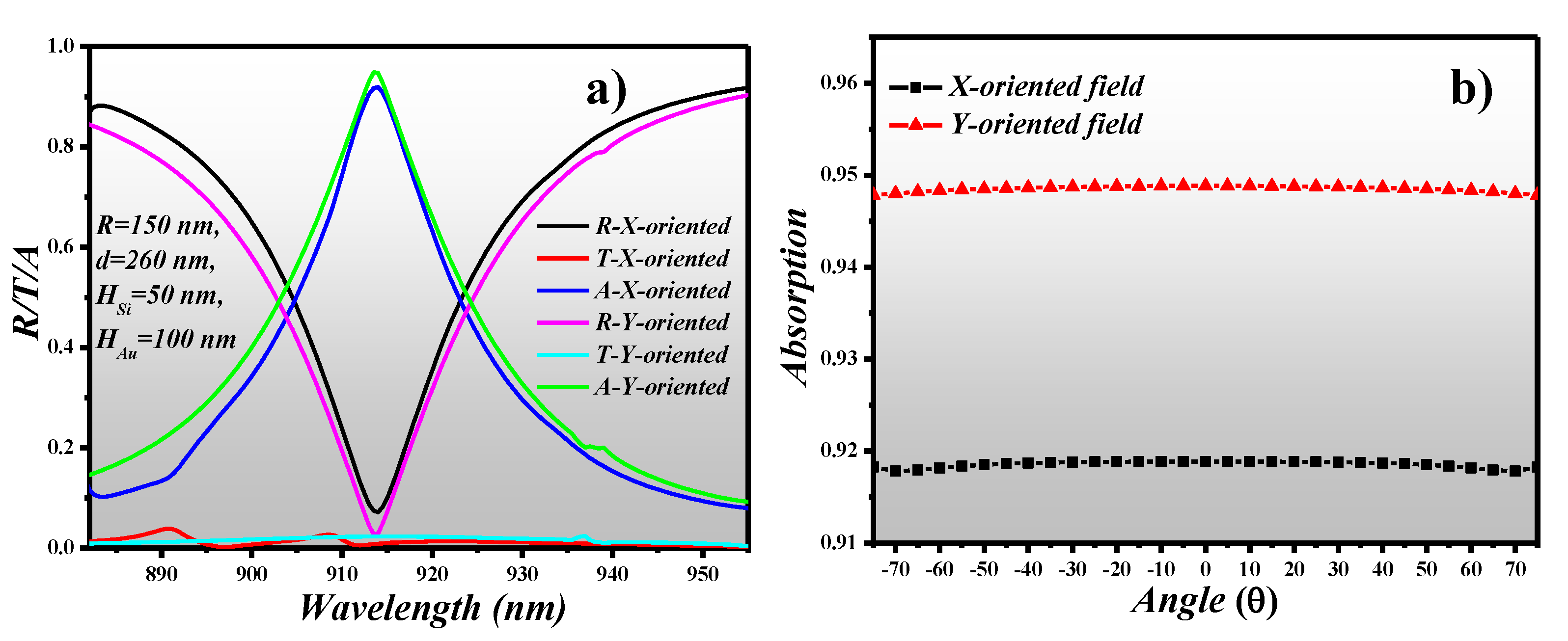

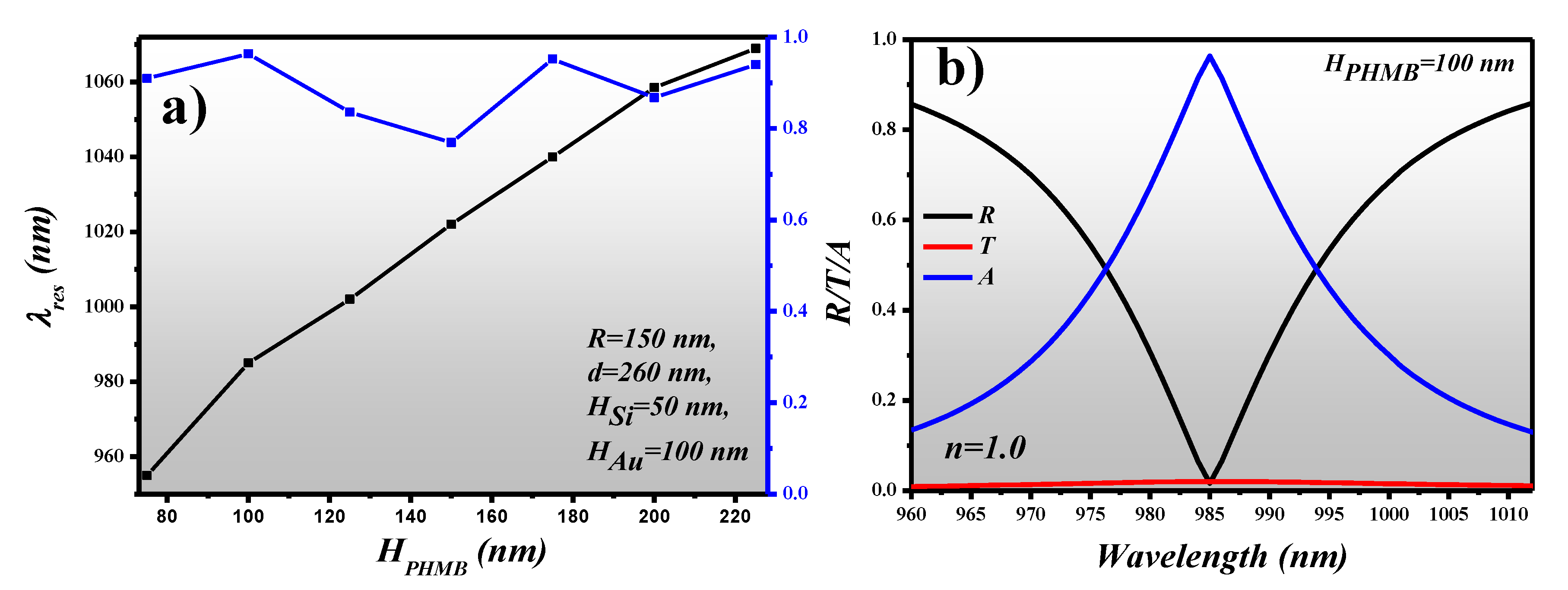
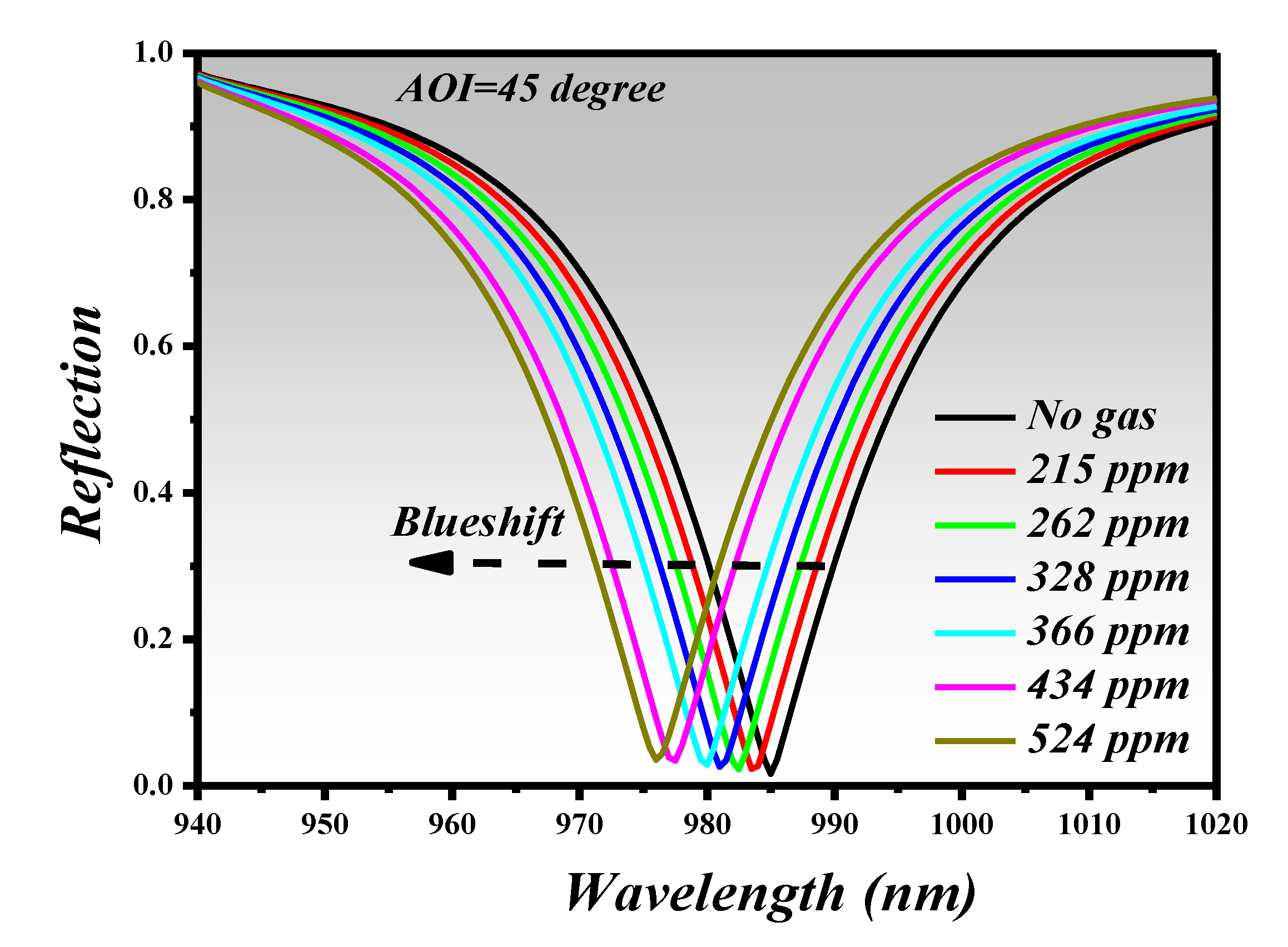

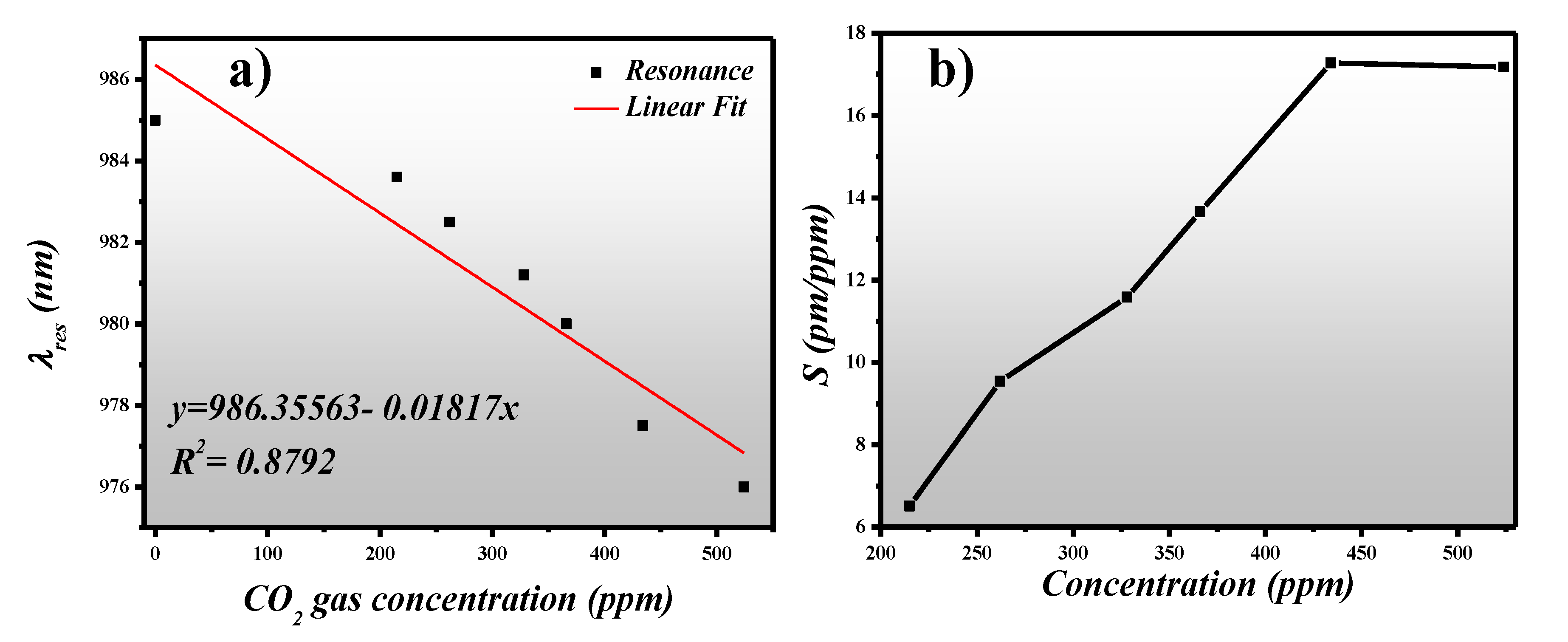
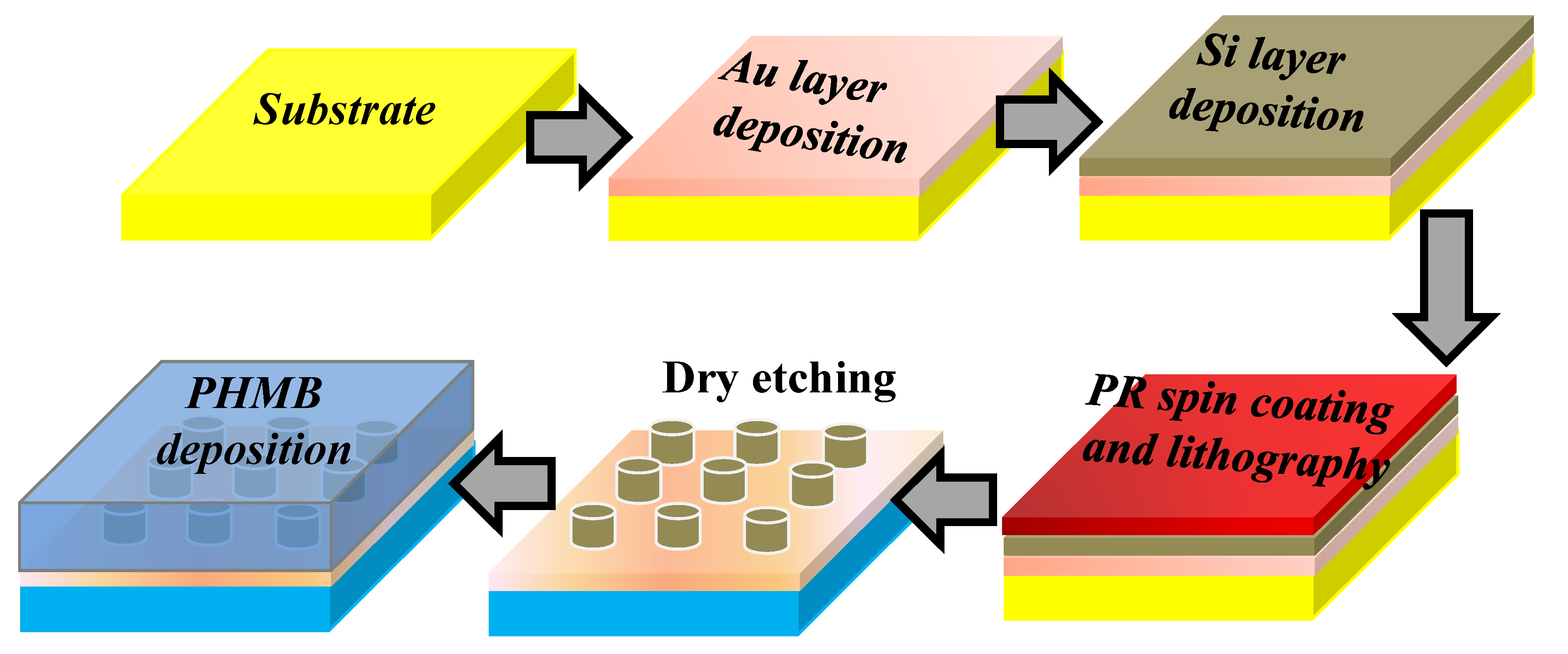
| Refractive Index (n) | CO2 Gas Concentration (ppm) | ∆λres (pm) |
|---|---|---|
| 1.54 | 215 | 0.96 |
| 1.53 | 262 | 1.15 |
| 1.52 | 328 | 1.34 |
| 1.51 | 366 | 1.53 |
| 1.50 | 366 | 1.53 |
| 1.49 | 434 | 1.72 |
| 1.48 | 524 | 1.91 |
| Refractive Index (n) | CO2 Gas Concentration (ppm) | λres (pm) | ∆λres (pm) |
|---|---|---|---|
| 1.55 | 0 | 985,000 | – |
| 1.54 | 215 | 983,600 | 1400 |
| 1.53 | 262 | 982,500 | 2500 |
| 1.52 | 328 | 981,200 | 3800 |
| 1.51 | 366 | 980,000 | 5000 |
| 1.49 | 434 | 977,500 | 7500 |
| 1.48 | 524 | 976,000 | 9000 |
Publisher’s Note: MDPI stays neutral with regard to jurisdictional claims in published maps and institutional affiliations. |
© 2021 by the authors. Licensee MDPI, Basel, Switzerland. This article is an open access article distributed under the terms and conditions of the Creative Commons Attribution (CC BY) license (http://creativecommons.org/licenses/by/4.0/).
Share and Cite
Kazanskiy, N.L.; Butt, M.A.; Khonina, S.N. Carbon Dioxide Gas Sensor Based on Polyhexamethylene Biguanide Polymer Deposited on Silicon Nano-Cylinders Metasurface. Sensors 2021, 21, 378. https://doi.org/10.3390/s21020378
Kazanskiy NL, Butt MA, Khonina SN. Carbon Dioxide Gas Sensor Based on Polyhexamethylene Biguanide Polymer Deposited on Silicon Nano-Cylinders Metasurface. Sensors. 2021; 21(2):378. https://doi.org/10.3390/s21020378
Chicago/Turabian StyleKazanskiy, Nikolay Lvovich, Muhammad Ali Butt, and Svetlana Nikolaevna Khonina. 2021. "Carbon Dioxide Gas Sensor Based on Polyhexamethylene Biguanide Polymer Deposited on Silicon Nano-Cylinders Metasurface" Sensors 21, no. 2: 378. https://doi.org/10.3390/s21020378
APA StyleKazanskiy, N. L., Butt, M. A., & Khonina, S. N. (2021). Carbon Dioxide Gas Sensor Based on Polyhexamethylene Biguanide Polymer Deposited on Silicon Nano-Cylinders Metasurface. Sensors, 21(2), 378. https://doi.org/10.3390/s21020378







